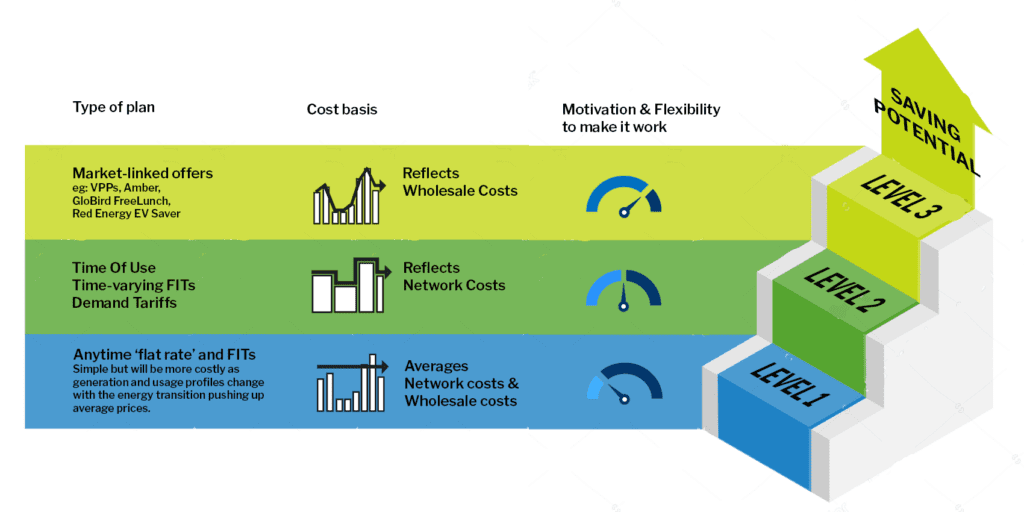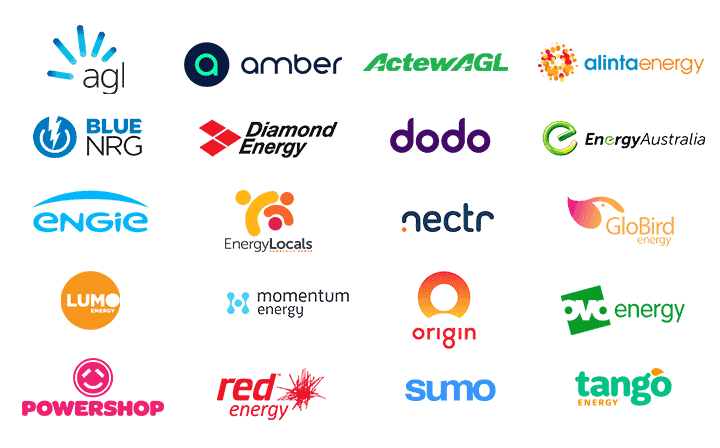There is increasing frustration about energy prices. Whether it’s falling feed-in tariffs or rising prices to buy electricity, even in the middle of the day, when consumers – especially solar owners receiving low feed-in tariffs – know it should be cheaper. So, how can you minimise the climbing cost of energy and unlock more significant savings?
The path to cheaper energy.
In WATTever’s analysis of residential electricity offers, we identified three levels of plan pricing. Most Australian households are still on flat-rate “level one” electricity plans. In this article, I’ll explain why these ‘average’ rate anytime plans will be more expensive. Plus, I’ll unpack two extra ‘levels’ of energy plans offering larger potential savings. This includes accessing lower grid rates along with higher export returns if you have solar and/or a battery. Let me introduce the ‘three levels of energy plans’.

We’ll start with a review of basic “level one” offers. Then step up to plans where the pricing more closely reflects actual costs, providing greater scope to actively reduce energy bills. This is a journey our household has taken over the last five years. As the market changes and ‘average’ rate plans offer less, we’ve ‘levelled up’ to plans providing the most extensive saving opportunities. People don’t think about energy plans this way – because most retailers want Aussies to keep buying electricity the way they always have. The industry knows electricity bought this way will become more expensive through the energy transition. Increasingly, motivated and/or flexible households that move beyond the basic plan level will benefit. While those that don’t (or can’t) take action, will pay more – which is a long-standing issue in the energy sector.
Level 1 offers - Flat rate, aka Anytime rates
Anytime rate electricity plans use a single rate which is entirely averaged. These plans are super simple to understand, but there is a catch most people don’t think about. Households pay a premium for someone to provide that one usage rate. The actual cost of providing energy jumps up and down across the day. This includes the cost of buying power from generators and using the electricity network to transmit electricity to the customer. So, the retailer flattens one or sometimes both costs and makes up a single 24x7x365 price. To ensure they cover their future costs – including protection from changing wholesale rates and the uncertainty about when a household might use energy, the retailer needs to apply a higher margin.
As a result, households on flat-rate plans end up paying more to use electricity for most hours of the day compared to Time of Use households. There’s no incentive for those on Anytime tariffs (without solar) to change when they use power because the cost is always the same, day and night.
For households that don’t have time or flexibility to do much (whether that’s changing when you might use energy or investing in technology), here are your best strategies for cost saving with level 1 plans.
Level 1 cost-saving strategies
Annual check and compare
Shopping around for a decent discount was the easiest way to reduce costs. However, the shakeout due to the global energy crisis has reduced the number and size of discount plans available. Prices have increased quickly. The discount retailers are struggling to stay afloat, let alone offer anything to soften the price surge. Sure, it still pays to compare at least annually and to shop around (go here to compare all publicly-listed energy plans with WATTever), but it’s not what it used to be. If that idea frustrates you, you might find you could make a next-level plan work. Or take the solar shortcut. If you have the opportunity, adding solar is still the biggest way to reduce your grid power needs and crush energy costs. Many solar owners begrudge the fact that feed-in tariffs have steadily fallen. But if you want to move up a level in solar savings, you’ll need to consider a different plan level. On a ‘flat rate’ style feed-in tariff, solar owners are exporting power on average at times when energy is cheapest. Buying power in the middle of a sunny day typically costs retailers a couple of cents a kWh, so the feed-in tariff is based on that low average value. Even with a moderate feed-in tariff, solar is definitely ‘worth it’. You’ll sidestep a big slice of grid power costs and share more sustainable energy. Head here for a quote on solar. If your household is more motivated and/or can be more flexible, then there are options to do better.Level 2 offers - Time Of Use/Demand Tariffs.
Networks are required to design their tariffs/pricing to be cost-reflective, incentivising households and businesses to use power outside peak time, reducing network congestion. Time of Use (ToU) plans reflect this, offering two or three rates across the day. Households on ToU tariffs effectively unlock lower rates during off-peak and shoulder periods. These lower rates apply for most hours of the day and are cheaper than corresponding anytime plans. Plus, many networks have created new daytime off-peak rates due to the abundance of solar, which drives down network demand. The so-called ‘solar sponge‘ tariffs offer low daytime prices. A ToU plan works out cheaper than flat-rate plans for typical households. Plus, the more electricity a home can shift to cheaper off-peak and shoulder periods, the more considerable the saving.
Demand Tariffs are more complicated. They calculate a demand/capacity charge based on the maximum amount of energy used during a short period (typically a 30 minute window) during the billing period. It’s not for many people. Unless you can tightly control your energy use; or have a battery that reduces the need to import power at peak periods, I’d recommend avoiding them as the potential for bill shock can be high. In effect you are penalised for your highest importing half-hour in a month (which may not even coincide with a network’s usage peak).
For solar (and battery) owners, plans that reflect network costs can also provide extra rewards. For example, time-varying FITs mean solar households get paid more when they export during the time their energy is more valued. One example is the Tesla Energy plan, which pays a 30 cent feed-in tariff for solar exported between 2-8pm. This might be ideal if you have some West-facing PV panels.
Level 2 offer strategies
Shop with your unique profile
If you’re already on a network time-based tariff, try to use your household’s electricity use profile when comparing options. This way, you’ll find the best fit for your situation. Creating some simple habits to run appliances when energy is cheapest offers you more savings. Think air conditioners, dishwashers, washing machines and dryers, pool pumps and more. Set the timer and trim your costs by using cheaper energy. For more information, check out WATTever’s essential guide to switching tariffs. However, if you are focused on accessing bigger rewards for your exports, then you’ll want to consider adding storage and moving to a level 3 market-linked plan, such as a VPP.Level 3 offers - Market-linked plans.
The final level of plans is even more cost-reflective. They more closely represent actual generation and network costs across the day. Some examples of level 3 plans include;
> Free lunch – Low cost (or free) daytime power – literally an hour or two of free electricity around midday, when actual wholesale prices are close to nothing. Examples include GloBird Energy FreeLunch in Victoria (free power from 12pm-2pm every day) and Red Energy EV Saver for EV owners (free power from 12pm-2pm on weekends).
> Virtual Power Plants (VPP) plans – offer battery owners the opportunity to have their battery discharge to the grid when power is in limited supply and market prices are high. In return, VPP plans reward with higher FITs or regular payments for access to use your battery.
> Market-linked plans such as Amber. Market-linked plans reflect the ever-changing fluctuation (every 5 or 30 minutes) in electricity prices. They enable households to access the very lowest rates but they also can be exposed to the very highest rates. On the other hand, if they export energy back to the grid when prices spike, expect to be paid far more handsomely than any standard daytime feed-in tariff. You will need a battery to avoid the inevitable price surges on market-linked plans.
Examples of VPP and market-linked plans that pay higher feed-in tariffs when wholesale rates are high include Amber, Discover Energy VPP Premium and ShineHub. Others like AGL and Simply Energy provide credits on each bill to compensate you for when the retailer uses your battery (to reduce their costs).
WATTever’s view is that market-linked plans offer the most significant saving potential – IF your household has the motivation and flexibility to take advantage of this. A ‘Free lunch’ type plan could provide households with a good opportunity if they have the flexibility to use a lot of energy in a small fixed window. This might include charging an EV, running multiple appliances etc. But typically, you’ll need solar, a battery and the willingness to shift loads or rely on automation to import and export at the optimal time to get the most out of market-linked plans. It’s getting easier to do, as technology is taking out the work in watching prices. These plans won’t just be for energy-saving nerds but will become something motivated households can tap into. Solar was once fringe. Now it’s super mainstream with 3 million Aussie households on board.
So, if you are looking to combat ever-increasing average grid energy prices, you can access sharper prices to advantage your household.
Level 3 plan strategies
Consider the right match
Before selecting a market-linked type plan, you’ll want to actively consider if you can take advantage of the opportunities. And can you avoid any downsides, like evening price spikes on directly market-linked plans like Amber. Will your battery cover the peak period? Automation solutions such as Amber’s SmartShift, ned and Charge HQ can help reduce the effort around market-linked plans. A VPP could be a great place to start by allowing the retailer or network to discharge your battery. The rewards available on VPPs typically aren’t as high as managing things yourself but require no effort. You can find more information on current VPP offers here.Is it time for you to level up?
There’s been a massive shift in the energy market in 2022. So, it’s not surprising that flat rate plans that were designed for another time, simply lock-in households to higher average prices. There are real opportunities that come with the fluctuating cost of energy. If you are motivated and/or have some flexibility, you can benefit from cheaper renewable energy costs and reduce expensive fossil-fuel generation. Your choice of plan is an essential factor in what you’ll pay. Many households are discovering that the efforts they make around energy will ultimately reward them.



